Sarah Sundin's Blog, page 333
August 7, 2015
Today in World War II History—Aug. 7, 1945

Nakajima Kikka (public domain)
70 Years Ago—Aug. 7, 1945: Japanese first fly Nakajima Kikka jet fighter, essentially a copy of the German Messerschmitt Me 262.
August 6, 2015
Today in World War II History—Aug. 6, 1940 & 1945
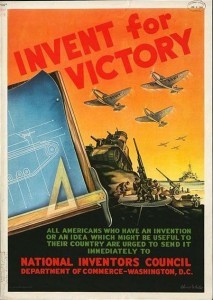 75 Years Ago—Aug. 6, 1940: First meeting of US National Inventors Council, to screen ideas from scientists and amateur inventors that might have military use—200,000 screened during war; 560 had value.
75 Years Ago—Aug. 6, 1940: First meeting of US National Inventors Council, to screen ideas from scientists and amateur inventors that might have military use—200,000 screened during war; 560 had value.
70 Years Ago—Aug. 6, 1945: Atomic bomb dropped on Hiroshima by US B-29 Enola Gay, flown by Col. Paul Tibbets Jr.; about 78,000 killed. Maj. Richard Bong, leading US fighter pilot ace (40 victories) and a Medal of Honor recipient, is killed testing a Lockheed Shooting Star jet fighter in Burbank, CA.
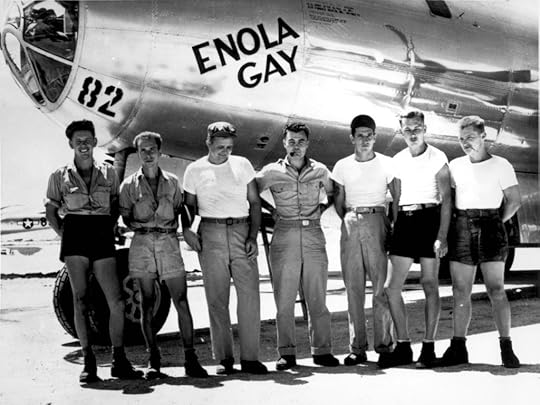
Col. Paul Tibbets and the crew of B-29 Superfortress Enola Gay, 5 Aug 1945. (US Army photo)
August 5, 2015
Through Waters Deep – Destroyer Tour: Below Decks
 For over one hundred years, destroyers have served as versatile naval workhorses. In World War II, US destroyers escorted convoys, hunted submarines, fought surface battles, bombarded shore positions, rescued downed airmen and stranded sailors, and served as radar pickets to detect and fight incoming kamikaze flights.
For over one hundred years, destroyers have served as versatile naval workhorses. In World War II, US destroyers escorted convoys, hunted submarines, fought surface battles, bombarded shore positions, rescued downed airmen and stranded sailors, and served as radar pickets to detect and fight incoming kamikaze flights.
In my new novel Through Waters Deep, Ens. Jim Avery serves on a fictional Gleaves-class destroyer, the USS Atwood. While researching the Waves of Freedom series, I visited two World War II destroyers, the Fletcher-class USS Cassin Young at the Charlestown Navy Yard in Boston and the Gearing-class USS Joseph P. Kennedy, Jr. at Battleship Cove in Fall River, MA. This week I’ll share photos from my tours:
Part 1—Topside: the various destroyer classes, and a bow-to-stern tour of the main deck.
Part 2—Below Decks: living quarters and working stations.
Part 3—Gunnery
To enter the giveaway for the Through Waters Deep apron, see the information at the end of the post.
For over one hundred years, destroyers have served as versatile naval workhorses. In World War II, US destroyers escorted convoys, hunted submarines, fought surface battles, bombarded shore positions, rescued downed airmen and stranded sailors, and served as radar pickets to detect and fight incoming kamikaze flights.
In Through Waters Deep, Ens. Jim Avery serves on a fictional Gleaves-class destroyer, the USS Atwood. While researching the Waves of Freedom series, I visited two World War II destroyers, the Fletcher-class USS Cassin Young at the Charlestown Navy Yard in Boston and the Gearing-class USS Joseph P. Kennedy, Jr. at Battleship Cove in Fall River, MA. This week I’ll share photos from my tours:
Part 1—Topside: the various destroyer classes, and a bow-to-stern tour of the main deck.
Part 2—Below Decks: living quarters and working stations.
Part 3—Gunnery
To enter the giveaway for the Through Waters Deep apron, see the information at the end of the post.
Living Quarters
With 160-345 men on board a 340-390-foot-long ship, space was at a premium. Enlisted men slept in tiered cots, and even the captain’s cabin was Spartan. The enlisted men ate in the mess, while the officers ate in the wardroom. Both the mess and the wardroom also served as social gathering areas, and in combat the wardroom was converted to a sick bay.
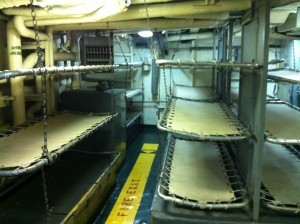
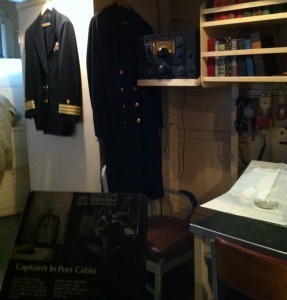
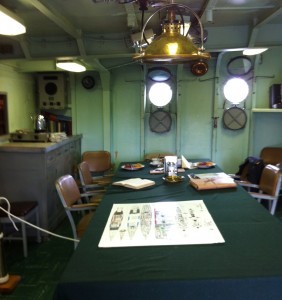
Sailors at Work
Destroyers had a galley (kitchen for us landlubbers), laundry, and offices. In addition to their routine duties, all crewmen also had general quarters duties. The steward would man a gun, and the carpenter’s mate would serve on a repair party.
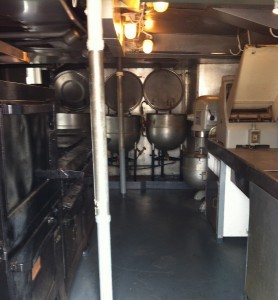

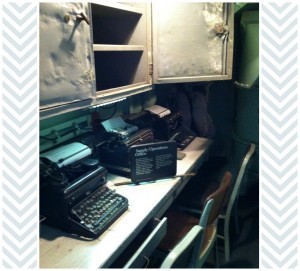
The Bridge
Up in the pilothouse, the captain or the officer of the deck stood watch over the navigation team. The bridge housed the helm (for steering the ship), the engine order telegraph (communicates requested speed to the engine room), a gyrocompass, and other navigational and communications equipment. Later in World War II, destroyers had a Combat Information Center behind the pilothouse, which collected sonar, radar, and communications data to direct battle plans. [Note: pictures below show Vietnam War-era equipment on the USS Joseph P. Kennedy, Jr.]
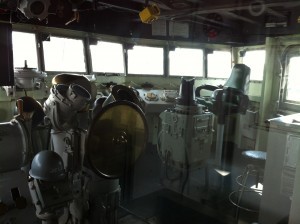
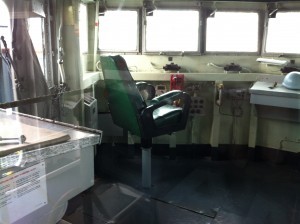
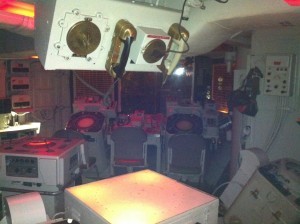
Engine and Boiler Rooms
Deep in the hull lay the engine and boiler (fire) rooms. The WWII-era destroyers had dual sets of boiler and engine rooms, which allowed the ship to maintain propulsion if damaged in combat.
In the boiler or fire room, giant boilers turned water to steam, which was pumped to the engine room. The steam powered the turbines, which turned the propeller shafts. The steam was then pumped to a condenser, sent through a deaerating feed tank to remove damaging gases, and circulated back to the boiler. Fuel oil powered the whole operation.
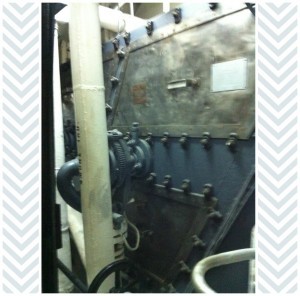
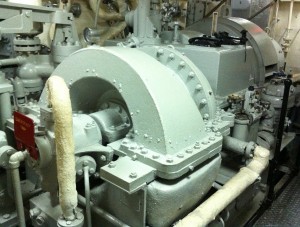
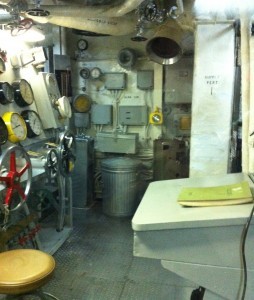
Come back Friday to see the reason for the destroyer’s existence—her armament.
Sources:
McComb, Dave. US Destroyers 1934-45: Pre-War Classes. Oxford: Osprey Publishing, 2010.
McComb, Dave. US Destroyers 1942-45: Wartime Classes. Oxford: Osprey Publishing, 2010.
Wiper, Steve. Warship Pictorial: USS Buchanan DD-484. Tucson, AZ: Classic Warships Publishing, 2009.
Harmon, J. Scott. U.S.S. Cassin Young (DD-793): A Fletcher Class Destroyer. Missoula, MT: Pictorial Histories Publishing Company, 1984.
Friedman, Norman. U.S. Destroyers: An Illustrated Design History. Annapolis, MD: Naval Institute Press, 1982.
Boston National Historical Park: USS Cassin Young. http://www.nps.gov/bost/learn/historyculture/usscassinyoung.htm
Destroyer History Foundation website. http://www.destroyerhistory.org
Tin Can Sailors Website. http://www.destroyers.org/index.html
 Giveaway
GiveawayI’m giving away this vintage Through Waters Deep apron, made by my talented author-buddy Marci Seither, and modeled by her lovely daughter! To enter, leave a comment below (US & Canada only please), on last week’s Tour of Boston, Part 5 article, or on Monday’s Destroyer Tour post. You can earn a maximum of three entries by leaving a comment on each of the three posts. If you can’t leave a comment, please send me an email to enter. Giveaway ends Wednesday, August 5, 2015 at midnight, Pacific Time. I’ll announce the winner here on Friday, August 7, 2015.
Today in World War II History—Aug. 5, 1940 & 1945
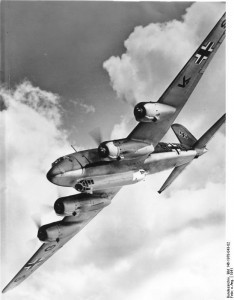
Focke-Wulf Fw 200 C Condor. (German Federal Archive, Bild: Bild 146-1978-043-02)
75 Years Ago—Aug. 5, 1940: German Fw 200 Condor long-range bombers begin patrols over convoy routes around Britain. Germany requires citizens to carry Ahnenpass, proving racial purity back to 1800.
70 Years Ago—Aug. 5, 1945: Missing items from Holy Roman Empire Imperial regalia are found buried in Nürnberg, Germany.
August 4, 2015
Through Waters Deep Anchors Aweigh Giveaway!
 Dive into my new series, Waves of Freedom, with book one, Through Waters Deep. When evidence of sabotage on the USS Atwood is found, Jim and Mary must work together to uncover the culprit. A bewildering maze of suspects emerges, and Mary is dismayed to find that even someone close to her is under suspicion. With the increasing pressure, Jim and Mary find that many new challenges–and dangers–await them in the midst of their budding romance.
Dive into my new series, Waves of Freedom, with book one, Through Waters Deep. When evidence of sabotage on the USS Atwood is found, Jim and Mary must work together to uncover the culprit. A bewildering maze of suspects emerges, and Mary is dismayed to find that even someone close to her is under suspicion. With the increasing pressure, Jim and Mary find that many new challenges–and dangers–await them in the midst of their budding romance.
Once again, I’ve teamed with Litfuse Publicity for a blog tour and giveaway!
Join me in celebrating the release of Through Waters Deep by entering to win an Anchors Aweigh prize pack!
 One grand prize winner will receive:
One grand prize winner will receive:
A copy of Through Waters Deep
A nautical tote bag
A set of compass rose notecards
A “Hope Anchors the Soul” journal
A Boston Tea Party earl grey tea set
A Through Waters Deep apron
A set of nautical tea towels
Enter today by clicking the icon below or by going to the contest page. But hurry, the giveaway ends on August 24th. ***Please note: simply commenting here on this post is not an entry. You must enter on the giveaway page.*** Giveaway open to US residents only. For contest rules, please see the giveaway page. The winner will be announced August 25th here on my blog.

Today in World War II History—Aug. 4, 1945
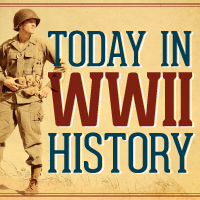 70 Years Ago—Aug. 4, 1945: Near Pegu Yoma, British destroy remnants of Japanese Twenty-Eighth Army resisting in Burma. German POW Kurt Rossmeisl escapes from Camp Butner, NC; he surrenders in 1959. WWII amputee Bert Shepard, former P-38 fighter pilot, pitches in a baseball game for the Washington Senators, the first man with an artificial leg to pitch in a major league baseball game.
70 Years Ago—Aug. 4, 1945: Near Pegu Yoma, British destroy remnants of Japanese Twenty-Eighth Army resisting in Burma. German POW Kurt Rossmeisl escapes from Camp Butner, NC; he surrenders in 1959. WWII amputee Bert Shepard, former P-38 fighter pilot, pitches in a baseball game for the Washington Senators, the first man with an artificial leg to pitch in a major league baseball game.
August 3, 2015
Through Waters Deep – Destroyer Tour: Topside
 For over one hundred years, destroyers have served as versatile naval workhorses. In World War II, US destroyers escorted convoys, hunted submarines, fought surface battles, bombarded shore positions, rescued downed airmen and stranded sailors, and served as radar pickets to detect and fight incoming kamikaze flights.
For over one hundred years, destroyers have served as versatile naval workhorses. In World War II, US destroyers escorted convoys, hunted submarines, fought surface battles, bombarded shore positions, rescued downed airmen and stranded sailors, and served as radar pickets to detect and fight incoming kamikaze flights.
In my new novel Through Waters Deep, Ens. Jim Avery serves on a fictional Gleaves-class destroyer, the USS Atwood. While researching the Waves of Freedom series, I visited two World War II destroyers, the Fletcher-class USS Cassin Young at the Charlestown Navy Yard in Boston and the Gearing-class USS Joseph P. Kennedy, Jr. at Battleship Cove in Fall River, MA. This week I’ll share photos from my tours:
Part 1—Topside: the various destroyer classes, and a bow-to-stern tour of the main deck.
Part 2—Below Decks: living quarters and working stations.
Part 3—Gunnery
To enter the giveaway for the Through Waters Deep apron, see the information at the end of the post.
WWII Destroyer Classes
When the United States entered World War II, many of the old WWI-era destroyers were still in use, dubbed “four-pipers” for their four stacks or funnels. In the 1920s, isolationism and treaty restrictions severely inhibited shipbuilding, but in the 1930s, eleven classes of destroyers were built, about a dozen a year. Each class improved on the one before, culminating with the latest pre-war classes, the Benson and Gleaves (see USS Lansdale below).
As war broke out in Europe in 1939, the United States accelerated shipbuilding and design. The first Fletcher-class destroyers were laid down in 1941 and commissioned in April 1942 (see USS Cassin Young below). The Fletchers were larger and could carry more armament and radar equipment, and 175 were built during the war. Crews loved their capability and ruggedness. Further improvements were made in the late-war classes, the Allen M. Sumner and the Gearing (see USS Joseph P. Kennedy, Jr. below). The Joseph P. Kennedy, Jr. is currently outfitted as in the Vietnam War.
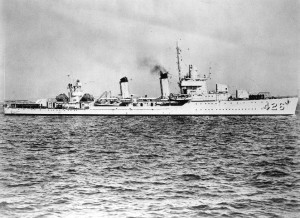

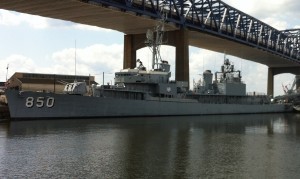
Bow to Stern
Let’s scan the USS Cassin Young from bow to stern. At the bow, we can see the anchor and the union jack (the flag with white stars on a blue background). Next we see the forward 5-inch guns in front of the bridge. The bridge superstructure contains the pilothouse and the captain’s emergency cabin, with the signal deck on top of the pilothouse, then the fire director, and several types of radar antennae on the mast.

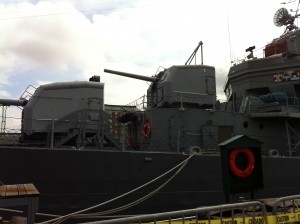
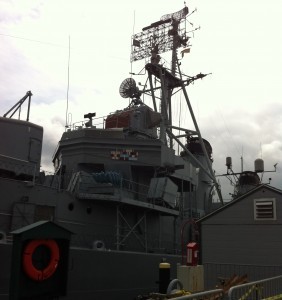
Aft of the bridge are the two funnels or stacks leading from the dual boiler (fire) rooms below, and the torpedo tubes (on the Gleaves-class destroyers, the torpedo tubes sat between the stacks). Past the quarterdeck sit the three aft 5-inch guns (there were usually only two on the prewar destroyers), antiaircraft guns, and depth-charge racks on the stern.
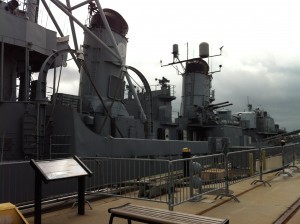
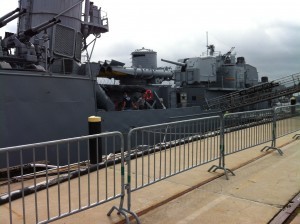
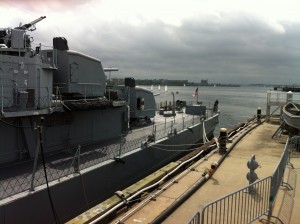
Topside Tour
Come aboard! Pictures are taken on both the Cassin Young and the Joseph P. Kennedy Jr. Up at the bow, we can see the anchor chains and the 5-inch guns more closely. Throughout the ship, you’ll see lines neatly coiled and hatches with ladders leading below decks.
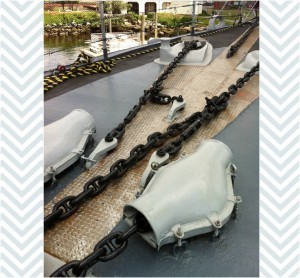
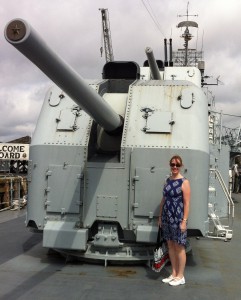
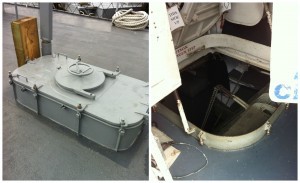
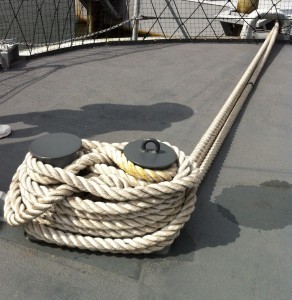
Alongside the bridge superstructure we can see the whaleboat, ready to rescue stranded sailors or airmen, or to take men to shore for liberty. Toward the stern we can see the torpedo tubes (and my humidity-exhausted son). The Cassin Young carried ten torpedoes in this mount, while the earlier classes usually had a quintuple mount.
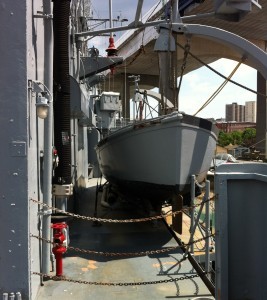
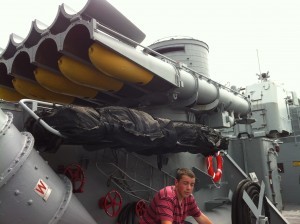
At the stern lie two depth charge racks, where explosives were rolled down to submarines below. Here we see the later model “teardrop” depth charge, while earlier in the war “ash can”-shaped depth charges were used. The ensign (US flag) flies proudly at the stern.

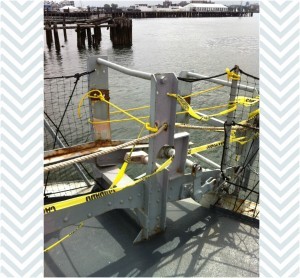
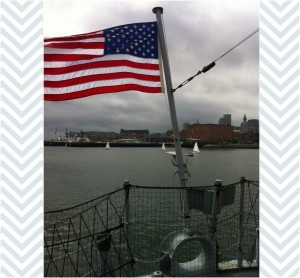
Come back Wednesday and go below decks to see how sailors lived and worked!
Sources:
McComb, Dave. US Destroyers 1934-45: Pre-War Classes. Oxford: Osprey Publishing, 2010.
McComb, Dave. US Destroyers 1942-45: Wartime Classes. Oxford: Osprey Publishing, 2010.
Wiper, Steve. Warship Pictorial: USS Buchanan DD-484. Tucson, AZ: Classic Warships Publishing, 2009.
Harmon, J. Scott. U.S.S. Cassin Young (DD-793): A Fletcher Class Destroyer. Missoula, MT: Pictorial Histories Publishing Company, 1984.
Friedman, Norman. U.S. Destroyers: An Illustrated Design History. Annapolis, MD: Naval Institute Press, 1982.
Boston National Historical Park: USS Cassin Young. http://www.nps.gov/bost/learn/historyculture/usscassinyoung.htm
Destroyer History Foundation website. http://www.destroyerhistory.org
Tin Can Sailors Website. http://www.destroyers.org/index.html
 Giveaway
GiveawayI’m giving away this vintage Through Waters Deep apron, made by my talented author-buddy Marci Seither, and modeled by her lovely daughter! To enter, leave a comment below (US & Canada only please), on last week’s Tour of Boston, Part 5 article, or on Wednesday’s Destroyer Tour post. You can earn a maximum of three entries by leaving a comment on each of the three posts. If you can’t leave a comment, please send me an email to enter. Giveaway ends Wednesday, August 5, 2015 at midnight, Pacific Time. I’ll announce the winner here on Friday, August 7, 2015.
Today in World War II History—Aug. 3, 1940 & 1945
 75 Years Ago—Aug. 3, 1940: Italian troops under Gen. Guglielmo Nasi invade British Somaliland from Italian Ethiopia. New song in the Top Ten: “When the Swallows Return to Capistrano.”
75 Years Ago—Aug. 3, 1940: Italian troops under Gen. Guglielmo Nasi invade British Somaliland from Italian Ethiopia. New song in the Top Ten: “When the Swallows Return to Capistrano.”
70 Years Ago—Aug. 3, 1945: Czechoslovakia denies citizenship to ethnic Germans and Hungarians.
August 2, 2015
Today in World War II History—Aug. 2, 1940 & 1945

Fires raging in Toyama, Japan during an American air raid, 1 Aug 1945 (US Air Force)
75 Years Ago—Aug. 2, 1940: British Royal Navy bombards Italian naval base on Sardinia.
70 Years Ago—Aug. 2, 1945: US B-29s drop 6000 tons of bombs on Nagasaki and Toyama, Japan. Japanese suffocate 387 Allied POWs in mine on Sado off Honshu.
August 1, 2015
Today in World War II History—Aug. 1, 1940 & 1945
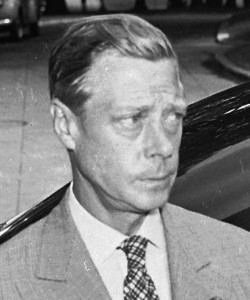
Duke of Windsor, August 1945. (US National Archives)
75 Years Ago—Aug. 1, 1940: Duke of Windsor (former King Edward VIII) sails from Portugal to Bahamas, foiling German kidnapping attempt.
70 Years Ago—Aug. 1, 1945: In US, penicillin is made available by prescription to civilians as tablets, ointment, and eye drops.



